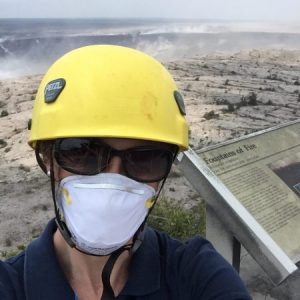October 11, 2019
Paths Through Science: Kristin Ludwig, Staff Scientist, USGS Natural Hazards Mission Area
Posted by AGU Career Center
Paths Through Science highlights the many diverse paths AGU’s scientists have charted across the  disciplines within Earth and space science through interviews with professionals in government, academia, industry, and non-profit sectors.
disciplines within Earth and space science through interviews with professionals in government, academia, industry, and non-profit sectors.
For International Day for Natural Disaster Reduction, we talked to Kristin Ludwig, a staff scientist in the United States Geological Survey (USGS) Natural Hazards Mission Area.
Check out the full audio interview for more about Ludwig’s career path to disaster mitigation work.
What is your earliest memory of being interested in science?
I became interested in science as a child while taking classes at the Denver Museum of Nature and Science – I still remember exploring dinosaur fossils in the museum halls, capturing crayfish in the nearby pond, and keeping an ant farm at home. I later enjoyed my sixth-grade science class, which introduced me to the natural history of the Rockies and the joy of studying science outside.
What are the steps you took through academia to your current career?
I completed my BS in Earth Systems at Stanford University and later earned my Ph.D. in Oceanography from the University of Washington. Upon completing graduate school, I pursued my interest in communications and public engagement through work with Seattle’s Pacific Science Center and later managing communications for the Integrated Ocean Drilling Program. After the Deepwater Horizon oil spill in 2010, I became interested in science policy, which led to becoming an American Association for the Advancement of Science (AAAS) Science and Technology Policy Fellow. As a Fellow at the United States Geological Survey (USGS) Natural Hazards Mission Area, I had the opportunity to learn first-hand how science is used in decision making for emergency response.
What were some challenges or obstacles you had to overcome to pursue your career choices?
Finding a good fit was one of the harder challenges I faced – I knew I wanted to work in some combination of Earth science and public engagement and tried several positions before finding a good career that combined many of my skill sets and interests.
What skills and knowledge, technical or non-technical, do you use in your work?
Teamwork and flexibility are two of the skills I draw on regularly in my work. It is so important – and rewarding – to find colleagues with whom you enjoy working and I am fortunate to have several collaborators who are high energy, full of good ideas, and have a good sense of humor.
What’s the most exciting part of your work?
The most exciting part of my work is the breadth of topics and disciplines I work with on a routine basis. On any given day, I may be talking with a seismologist, an anthropologist, an ecologist, a designer, an urban planner, or an oceanographer – or others! Interdisciplinary science is one aspect of working hazards that I especially enjoy – risk reduction truly requires a whole community approach.
Describe the most discouraging part of your work. How do you overcome this limitation?
One of the most challenging parts of my work is the frequent realization that change is slow. Reducing risk from different types of hazards – whether they be geophysical, climatological, or even human-caused – is a long and hard process and despite the best science, we aren’t always able to effect change on needed timescales. This said, it’s important to continue to better understand hazards, talk with communities about their risks, and collaborate to identify solutions and to keep working on these inherently difficult challenges!
What is something you wish you had known earlier in your career? What advice do you have for students considering a career in the Earth and space sciences?
Know that it’s ok to try different things! If a career is not a good fit, be confident in your power to pivot and change direction to find something where you can thrive and grow.


 On the Job is an AGU blog, that provides career advice and workforce guidance to geoscience students, early-career and established professionals who are interested in pursuing professional enrichment.
On the Job is an AGU blog, that provides career advice and workforce guidance to geoscience students, early-career and established professionals who are interested in pursuing professional enrichment.